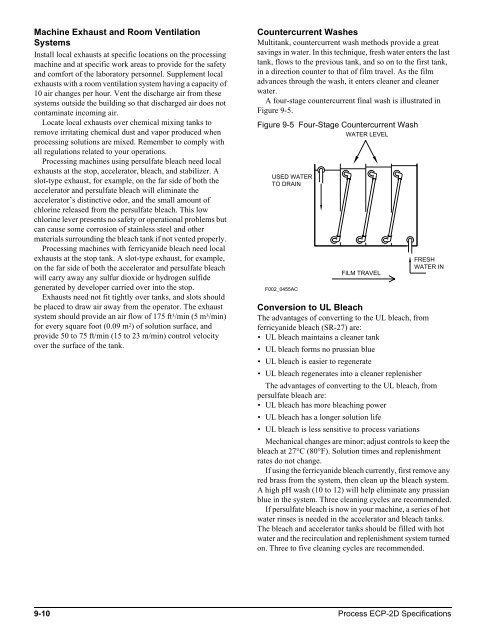films and process sequence ... - Kodak
films and process sequence ... - Kodak
films and process sequence ... - Kodak
Create successful ePaper yourself
Turn your PDF publications into a flip-book with our unique Google optimized e-Paper software.
Machine Exhaust <strong>and</strong> Room Ventilation<br />
Systems<br />
Install local exhausts at specific locations on the <strong>process</strong>ing<br />
machine <strong>and</strong> at specific work areas to provide for the safety<br />
<strong>and</strong> comfort of the laboratory personnel. Supplement local<br />
exhausts with a room ventilation system having a capacity of<br />
10 air changes per hour. Vent the discharge air from these<br />
systems outside the building so that discharged air does not<br />
contaminate incoming air.<br />
Locate local exhausts over chemical mixing tanks to<br />
remove irritating chemical dust <strong>and</strong> vapor produced when<br />
<strong>process</strong>ing solutions are mixed. Remember to comply with<br />
all regulations related to your operations.<br />
Processing machines using persulfate bleach need local<br />
exhausts at the stop, accelerator, bleach, <strong>and</strong> stabilizer. A<br />
slot-type exhaust, for example, on the far side of both the<br />
accelerator <strong>and</strong> persulfate bleach will eliminate the<br />
accelerator’s distinctive odor, <strong>and</strong> the small amount of<br />
chlorine released from the persulfate bleach. This low<br />
chlorine lever presents no safety or operational problems but<br />
can cause some corrosion of stainless steel <strong>and</strong> other<br />
materials surrounding the bleach tank if not vented properly.<br />
Processing machines with ferricyanide bleach need local<br />
exhausts at the stop tank. A slot-type exhaust, for example,<br />
on the far side of both the accelerator <strong>and</strong> persulfate bleach<br />
will carry away any sulfur dioxide or hydrogen sulfide<br />
generated by developer carried over into the stop.<br />
Exhausts need not fit tightly over tanks, <strong>and</strong> slots should<br />
be placed to draw air away from the operator. The exhaust<br />
system should provide an air flow of 175 ft 3/min (5 m 3/min)<br />
for every square foot (0.09 m 2) of solution surface, <strong>and</strong><br />
provide 50 to 75 ft/min (15 to 23 m/min) control velocity<br />
over the surface of the tank.<br />
Countercurrent Washes<br />
Multitank, countercurrent wash methods provide a great<br />
savings in water. In this technique, fresh water enters the last<br />
tank, flows to the previous tank, <strong>and</strong> so on to the first tank,<br />
in a direction counter to that of film travel. As the film<br />
advances through the wash, it enters cleaner <strong>and</strong> cleaner<br />
water.<br />
A four-stage countercurrent final wash is illustrated in<br />
Figure 9-5.<br />
Figure 9-5 Four-Stage Countercurrent Wash<br />
USED WATER<br />
TO DRAIN<br />
F002_0455AC<br />
WATER LEVEL<br />
FILM TRAVEL<br />
FRESH<br />
WATER IN<br />
Conversion to UL Bleach<br />
The advantages of converting to the UL bleach, from<br />
ferricyanide bleach (SR-27) are:<br />
UL bleach maintains a cleaner tank<br />
UL bleach forms no prussian blue<br />
UL bleach is easier to regenerate<br />
UL bleach regenerates into a cleaner replenisher<br />
The advantages of converting to the UL bleach, from<br />
persulfate bleach are:<br />
UL bleach has more bleaching power<br />
UL bleach has a longer solution life<br />
UL bleach is less sensitive to <strong>process</strong> variations<br />
Mechanical changes are minor; adjust controls to keep the<br />
bleach at 27°C (80°F). Solution times <strong>and</strong> replenishment<br />
rates do not change.<br />
If using the ferricyanide bleach currently, first remove any<br />
red brass from the system, then clean up the bleach system.<br />
A high pH wash (10 to 12) will help eliminate any prussian<br />
blue in the system. Three cleaning cycles are recommended.<br />
If persulfate bleach is now in your machine, a series of hot<br />
water rinses is needed in the accelerator <strong>and</strong> bleach tanks.<br />
The bleach <strong>and</strong> accelerator tanks should be filled with hot<br />
water <strong>and</strong> the recirculation <strong>and</strong> replenishment system turned<br />
on. Three to five cleaning cycles are recommended.<br />
9-10 Process ECP-2D Specifications

















